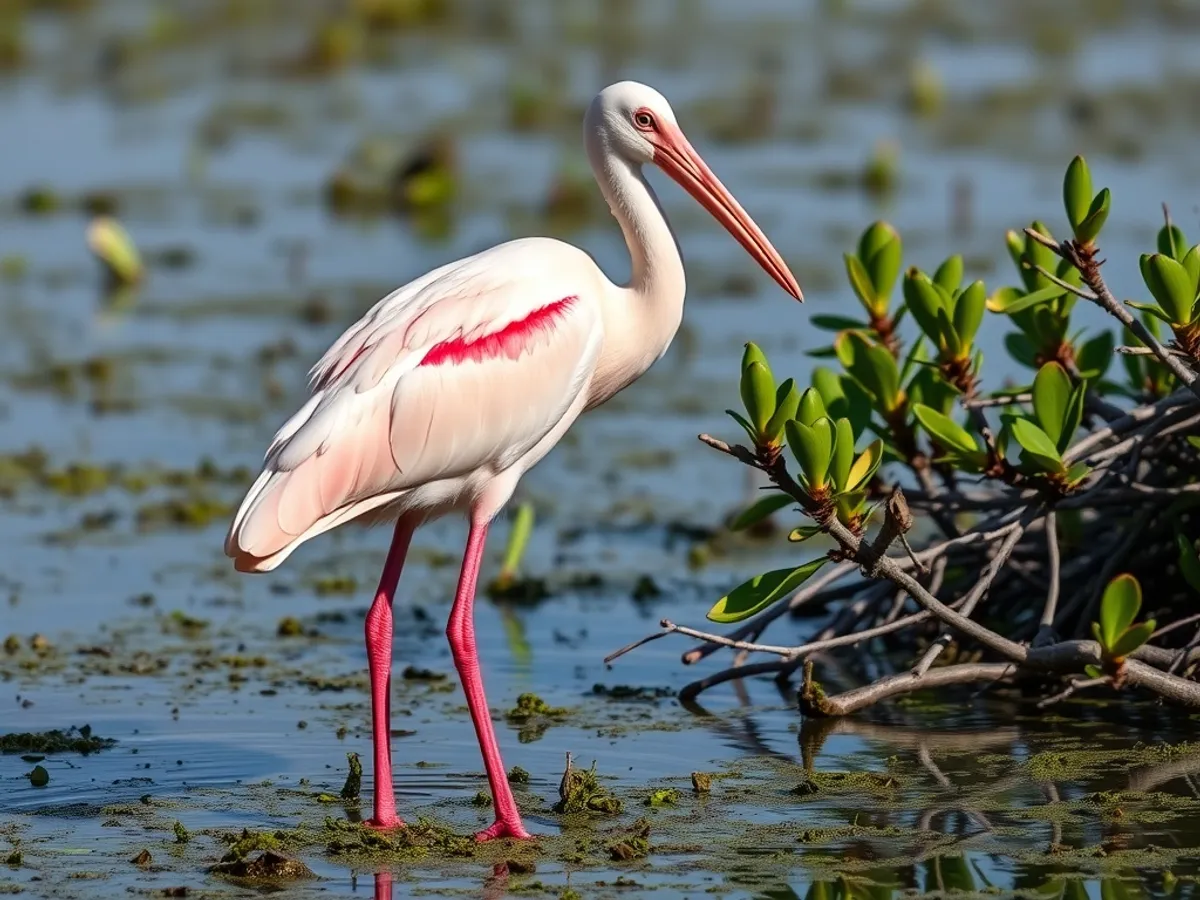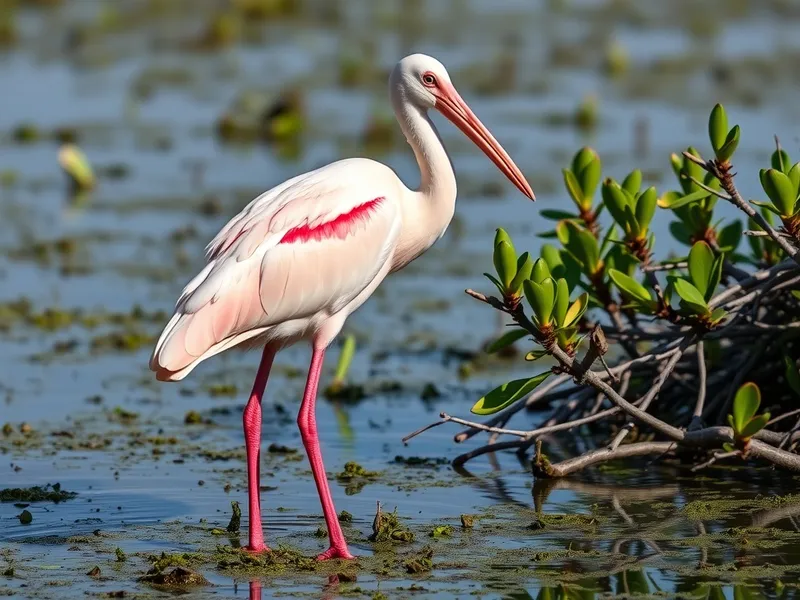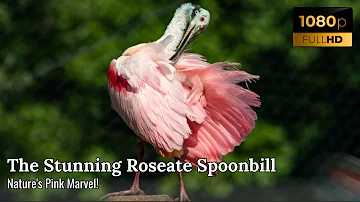
Roseate Spoonbill
Platalea ajaja

Meet the Roseate Spoonbill
The Roseate Spoonbill is a striking wading bird known for its vibrant pink plumage and distinctive, spatula-shaped bill. Found in marshes, mangroves, and wetlands of the Americas, this bird feeds by sweeping its bill side to side in shallow waters to catch small aquatic prey. Adults display brilliant pink feathers, especially during breeding season, due to pigments in their diet. Their social nature leads them to nest in colonies, often alongside other wading birds. Despite their flamboyant appearance, their camouflage among the rosy hues of their habitat is surprisingly effective.
Classification
Bird
Habitat
Marshes, mangroves, and coastal wetlands
Diet
Carnivore
Lifespan
10-15 years
Conservation
Least Concern
Weight
1.2-1.8 kg
📖Fascinating Facts
Vivid Coloration
Their pink plumage comes from carotenoids in the crustaceans and aquatic insects they eat.
Spoon-shaped Bill
Their wide, flat bill is perfectly adapted for sweeping through shallow water to detect and catch prey by touch.
Colonial Nesters
Roseate Spoonbills nest in large colonies, often alongside other water birds like herons, egrets, and ibises.
📋Detailed Description
The Roseate Spoonbill (Platalea ajaja) is a medium-sized wading bird, measuring 71–86 cm (28–34 in) in length with a wingspan of 120–133 cm (47–52 in) and weighing 1.2–1.8 kg (2.6–4.0 lbs). Its most distinctive feature is its long, flat, spatula-shaped bill, which it uses to sift through shallow water for prey. The plumage is predominantly pink, with shades ranging from pale blush to deep magenta, especially vivid on the shoulders and tail coverts. The intensity of the coloration is diet-dependent, derived from carotenoid pigments found in crustaceans and other aquatic invertebrates. Adults have a bare greenish head and red eyes, while juveniles are paler with feathered heads. Roseate Spoonbills are highly social, often forming large, noisy colonies with other wading birds such as herons, egrets, and ibises. They are diurnal, foraging mainly at dawn and dusk. Their flight is strong and direct, with necks and legs extended. The species is non-migratory in tropical regions but exhibits seasonal movements in the northern parts of its range. Their vocalizations include low grunts and croaks, mostly heard at nesting sites. The Roseate Spoonbill plays a vital ecological role as a top invertebrate predator in wetland ecosystems.
💡 Did you know?
Unlike flamingos, the Roseate Spoonbill's pink coloration can fade if their diet lacks enough crustaceans and other pigment-rich foods.
🔬Research & Sources
Wikipedia Summary
The roseate spoonbill is a social wading bird of the ibis and spoonbill family, Threskiornithidae. It is a resident breeder in both South and North America. The roseate spoonbill's pink color is diet-derived, consisting of the carotenoid pigment canthaxanthin, like the American flamingo.
Last Modified: 5/28/2025
🎭Behavior & Social Structure
Roseate Spoonbills exhibit a characteristic side-to-side sweeping motion of their partially open bills in shallow water, using tactile foraging to detect and capture prey such as small fish, crustaceans, aquatic insects, and mollusks. This feeding technique is highly efficient in turbid waters where visibility is low. They often forage in groups, which may help stir up prey and reduce predation risk. Socially, spoonbills are gregarious, roosting and nesting in colonies that can number in the hundreds. They engage in mutual preening and display complex courtship behaviors, including bill clapping and ritualized preening. Daily routines include periods of active feeding interspersed with resting and preening, typically in trees or dense shrubs near water. During the breeding season, they become more territorial and aggressive, defending nest sites from intruders.
👶Reproduction & Life Cycle
Breeding occurs in colonies, often alongside other wading birds, from late winter to early summer depending on latitude (typically February–June in North America). Courtship involves elaborate displays such as bill clapping, head shaking, and mutual preening. Nests are constructed from sticks and lined with softer materials, usually placed in mangroves, trees, or shrubs above water. The female lays 2–5 pale, speckled eggs, which are incubated by both parents for about 22–24 days. Both parents share feeding duties, regurgitating food for the chicks. The young fledge at around 5–6 weeks but may remain dependent on parents for several more weeks. Roseate Spoonbills typically reach sexual maturity at 3 years of age.
🛡️Adaptations & Survival
The spoon-shaped bill is a specialized adaptation for tactile foraging, allowing the bird to detect prey by touch rather than sight. Their long legs and partially webbed feet enable efficient wading in soft, muddy substrates. The vibrant pink coloration, derived from dietary carotenoids (notably canthaxanthin), may serve as a signal of health and fitness during mate selection. Bare, greenish skin on the head reduces feather fouling during feeding in muddy environments. Social nesting provides protection against predators and increases reproductive success. Their ability to exploit a wide range of wetland habitats, from freshwater marshes to saline lagoons, demonstrates ecological flexibility.
🎨Cultural Significance
The Roseate Spoonbill is an iconic species in the Americas, often celebrated for its striking appearance. In some cultures, it is associated with beauty, grace, and the vibrancy of wetland ecosystems. It features in the folklore and art of indigenous peoples and is a popular subject in birdwatching and ecotourism, particularly in Florida and the Gulf Coast. The bird has also served as a symbol of successful conservation, reflecting the recovery of wading bird populations following protective legislation.
🔬Recent Research & Discoveries
Recent research has focused on the effects of environmental contaminants, such as mercury and pesticides, on reproductive success and chick development. Studies using satellite telemetry have revealed previously unknown migratory and dispersal patterns, particularly among populations in the United States and the Caribbean. Ongoing work is examining the impact of climate change on breeding phenology and habitat use. Genetic studies have clarified the species' relationship to other spoonbills and ibises, supporting its placement in the genus Platalea. There is also interest in the role of carotenoid metabolism in plumage coloration and its implications for mate choice.
🎥Wildlife Videos

Roseate Spoonbills: Hauntingly Beautiful Swamp Hunters
The roseate spoonbill has a killer bill and wears a pink bride gown. Get Animalogic Merch: https://bit.ly/3SXGrXL Support ...
Animalogic

Roseate Spoonbill
In the warm and shallow waters, located in the coastal areas from the southern United States to Chile and Argentina, lives a ...
Victoria Restrepo Nature Documentaries

How The Dutch Managed To Save The Spoonbill | Our World
Embark on a captivating journey through the wetlands of the Netherlands, exploring the lives of spoonbills and the extraordinary ...
Our World

Unveiling the secrets of the Roseate Spoonbill
Join us in this captivating journey as we delve into the enchanting world of the Roseate Spoonbill! In this video, we will uncover ...
GREEN STREAM

Florida Wildlife Photography at Circle B Bar | Canon R5 MKII
I visited Circle B Bar Reserve in Lakeland, Florida for the very first time, and it did not disappoint. From massive alligators to ...
Satesh Ramjattan

Roseate Spoonbill | The Stunning Beauty of Platalea ajaja in the Wild
Explore the captivating world of the Roseate Spoonbill, a striking wading bird known for its vibrant pink plumage and unique ...
Sounds Of Nature For All
🌍Habitat Information
The Roseate Spoonbill typically inhabits Marshes, mangroves, and coastal wetlands environments. Roseate Spoonbills have adapted to their environments with specialized features and behaviors.
Primary Habitat:
Marshes, mangroves, and coastal wetlands
More detailed habitat information will be available soon.
🛡️Conservation Status
The Roseate Spoonbill is currently classified as Least Concern. Conservation efforts are crucial for preserving this species for future generations.
Common Threats:
- 🏠Habitat loss and fragmentation
- 🌡️Climate change impacts
- 🎯Hunting and poaching
- 🏭Human-wildlife conflict
⚠️Threats & Conservation Challenges
Historically, Roseate Spoonbills were heavily hunted for their plumage, leading to severe population declines in the late 19th and early 20th centuries. Today, populations have rebounded but remain vulnerable to habitat loss and degradation, especially the drainage and development of wetlands, pollution, and disturbance from human activity. Climate change poses additional threats through sea-level rise and altered hydrological cycles. In some regions, water management practices and pesticide use can reduce food availability or cause direct harm. Despite these challenges, the species is currently listed as Least Concern by the IUCN, with stable or increasing populations in most areas, though local declines may occur.
🔬Scientific Classification
Scientific Name
Platalea ajaja
Classification Hierarchy
🔍 About Taxonomic Classification
Taxonomic classification is a hierarchical system used by scientists to classify and organize living organisms based on shared characteristics and evolutionary relationships.
The system moves from broad categories (Kingdom) to increasingly specific ones, with each animal's scientific name typically consisting of its Genus and species.
📝Community Notes
Share your observations and insights about the Roseate Spoonbill with our community of wildlife enthusiasts.
Join Our Community
Sign in to share your observations and connect with fellow wildlife enthusiasts.
Sign In to ContributeNo community notes yet
Be the first to share your observations about the Roseate Spoonbill!
Explore Roseate Spoonbill
Select a tab above to learn more about this amazing animal.
📸Photo Gallery
No photos available for this animal yet.
🌟Discover More Wildlife
Continue your journey of discovery with more fascinating animals from our database
